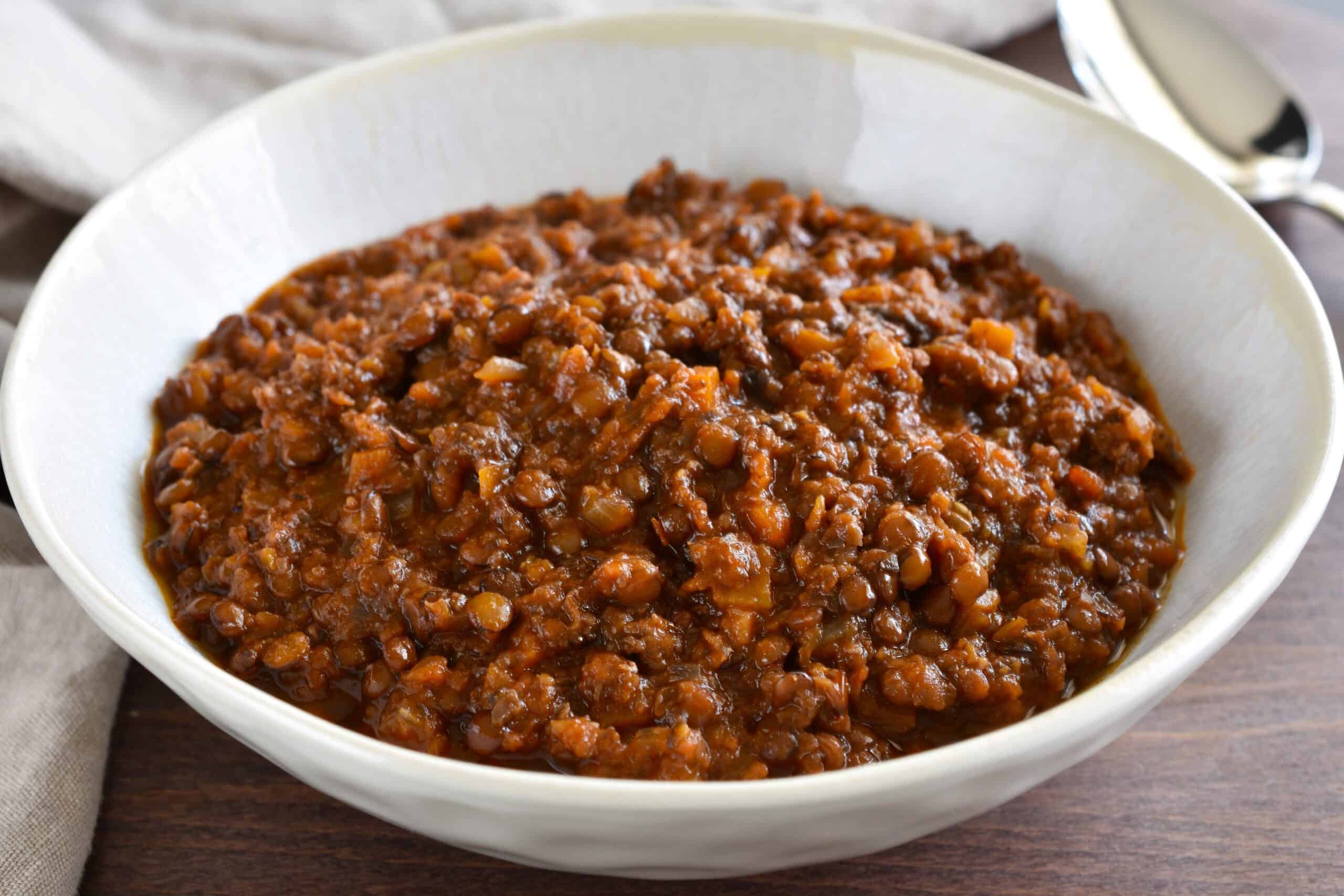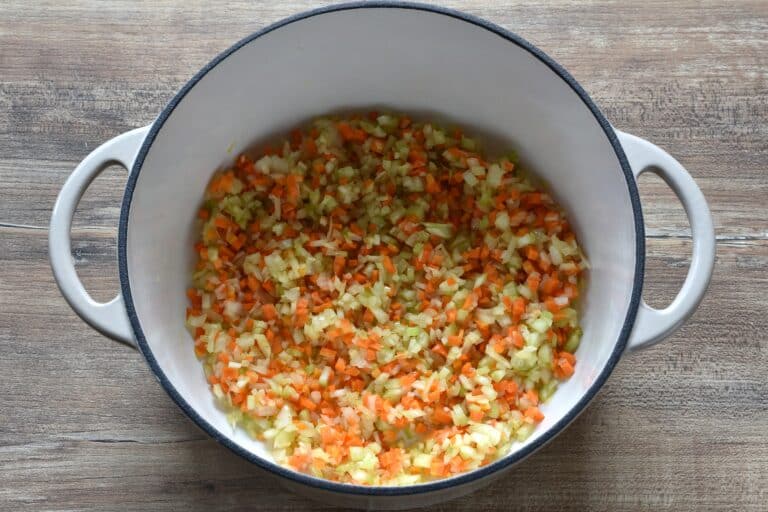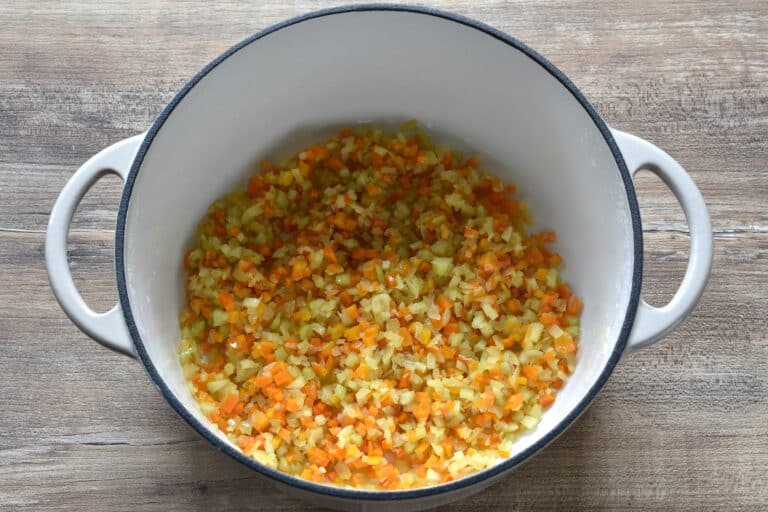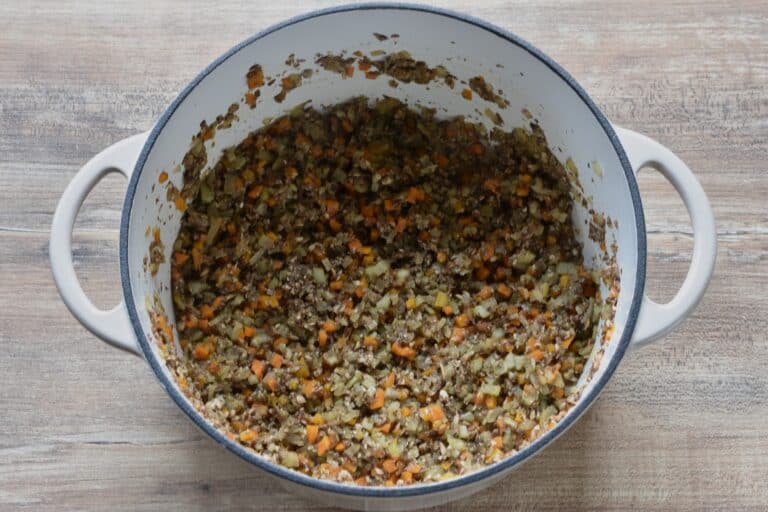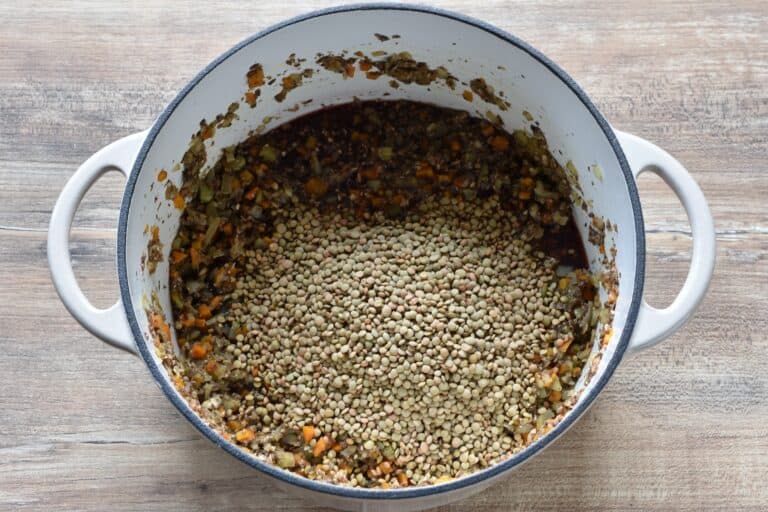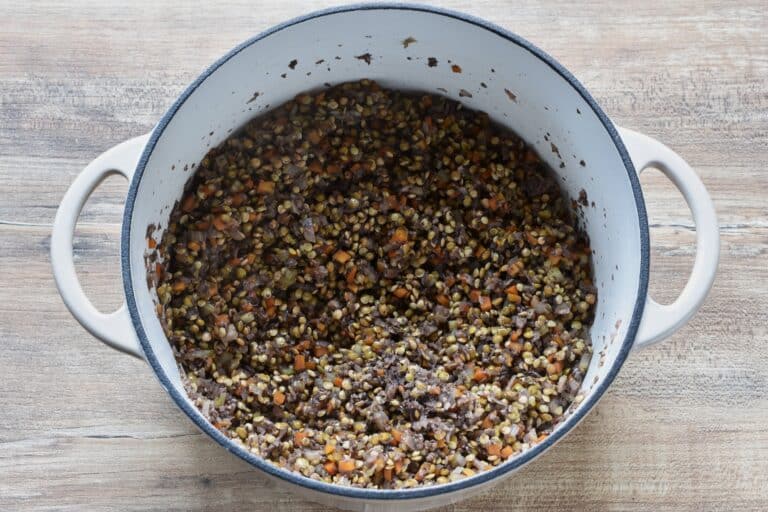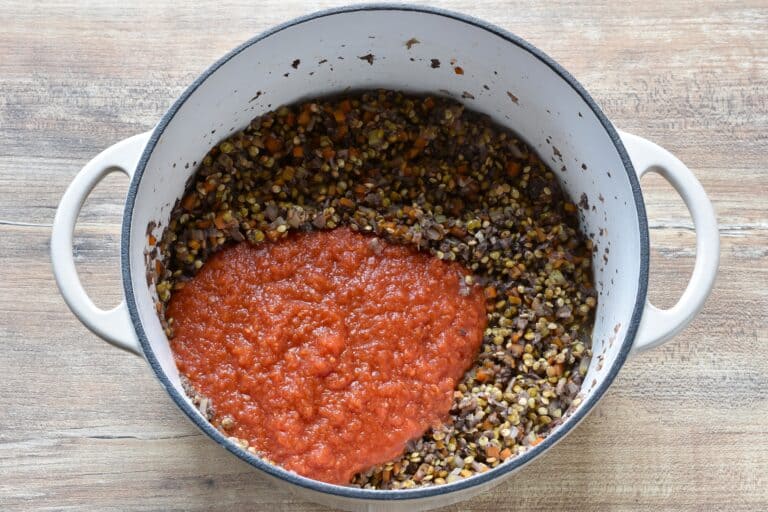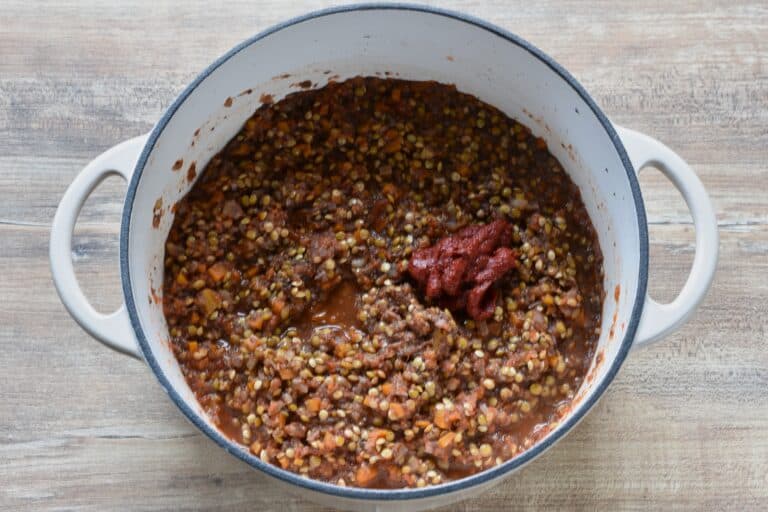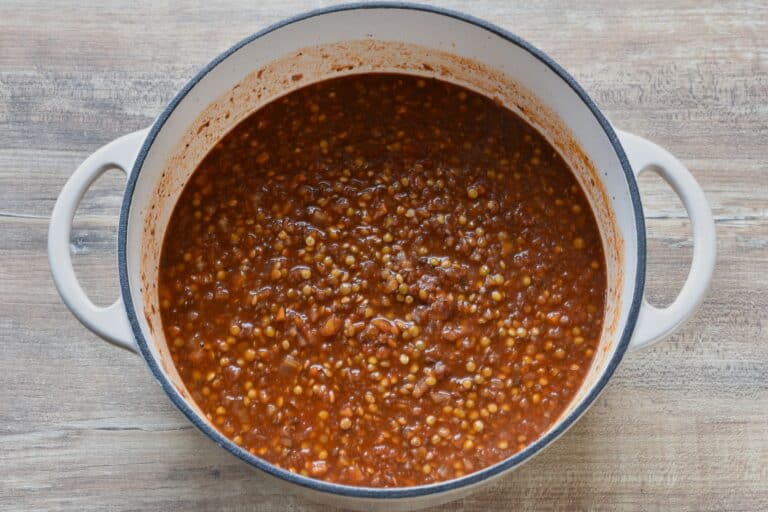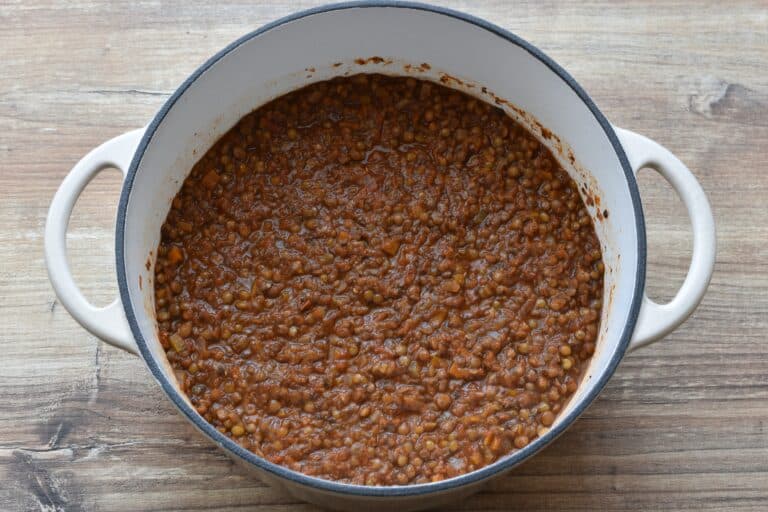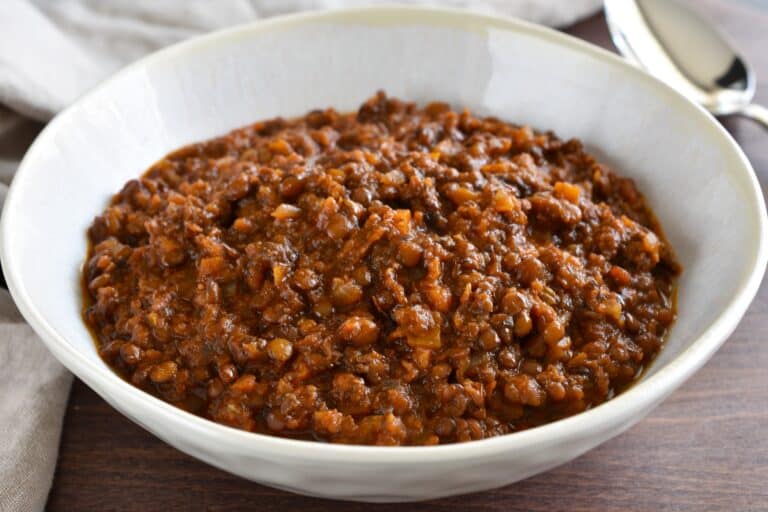Here is a vegan ragu that is absolutely oozing with authentic Italian flavours! It’s equally as delicious and satisfying as the legendary ragù bolognese from the region of Emilia Romagna in central Italy.
In the spaghetti bolognese sauce that most of us grew up eating and loved, it wasn’t so much the meat that provided the flavour but all the other ingredients. Soffritto, red wine, tomato sauce, vegetable broth, extra virgin olive oil, and a simple seasoning make an amazingly flavoursome base for Italian ragu and lots of other sauces, whether they contain meat or not.
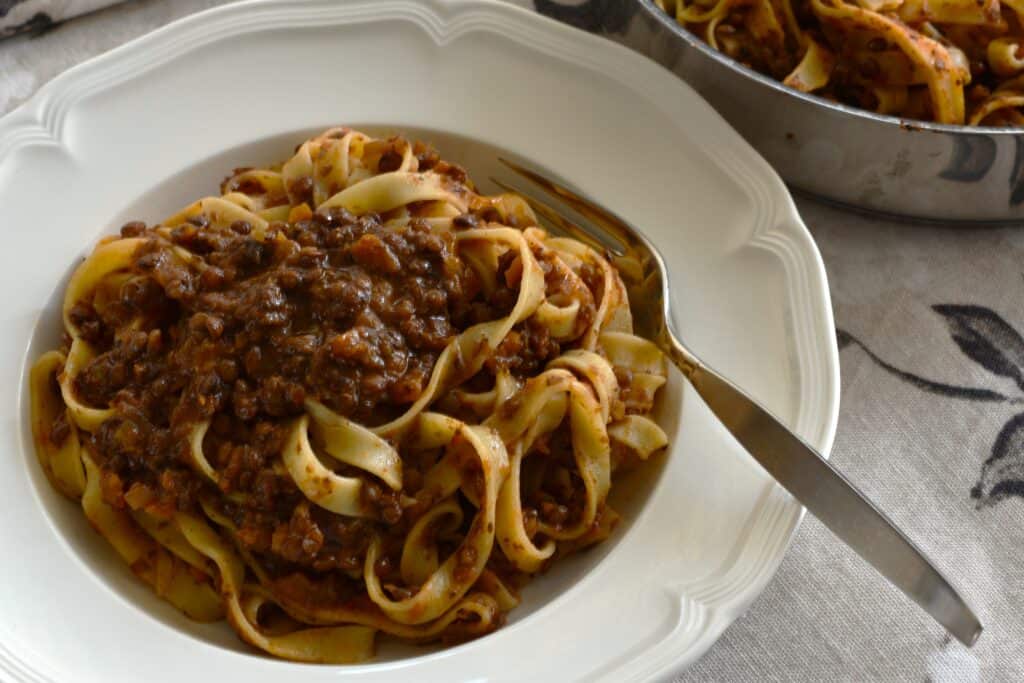
This vegan ragu is surprisingly simple to make. The most time-consuming part is chopping the soffritto (onion, carrot and celery). You then sauté the soffritto, adding the chopped mushrooms after about 10 minutes. The other ingredients go into the pan in quick succession, and then it’s just a question of slow-cooking everything on low heat. You’ll find the full ingredient list and step-by-step instructions with photos in the recipe card at the bottom of the page.
You can use this vegan ragu for making bolognese pasta dishes, lasagne and cannelloni. It’s also great as a filling for savoury pancakes, ravioli, tortellini, and arancini di riso. You can easily adapt it to make shepherd’s pie, pasticcio and even moussaka. It could also be used as a base for lentil burgers or “meatballs“.
You might be wondering what the difference is between ragu and bolognese. Well, to start with, bolognese is the most widely used term, especially outside Italy. Let’s have a quick look at the main differences and why I’ve called this recipe vegan ragu and not bolognese.

What is the difference between ragu and bolognese sauce?
Ragù alla bolognese, meaning “ragù from Bologna” or bolognese sauce as we anglophiles know it, originates from the city of Bologna. Did you know there is actually an official recipe for this legendary sauce? The latest version of the ragù bolognese recipe was registered in the Camera di Commercio, Industria, Artigianato, e Agricoltura di Bologna (Chamber of Commerce) on 21 April 2023, substituting the previous one of 17 October 1982.
Ragù, on the other hand, is native to the entire region of Emilia Romagna rather than just the city of Bologna. It’s a broader term that refers to a minced or chopped meat sauce cooked over low heat for a long period of time. Since bolognese falls within this category, it, too, is a ragù. There are also other ragu recipes originating from other parts of Italy, like ragù alla napoletana, ragù alla barese, and ragù alla veneta.
Ragu often contains more tomato sauce than bolognese, for example, and the meat used is not always minced. Red wine is used for ragù, whereas bolognese foresees either white or red. Ragu is also usually denser than bolognese.
Italians are very proud of their culinary heritage, and rightly so. They can get very uppity about us foreigners calling our concoctions bolognese, pesto, or carbonara, for example, when the ingredients and methods used are nothing like the real thing. I can understand that. I try to keep all my Italian recipes as authentic as possible, and the only things I substitute are animal products, which I replace with vegan alternatives.
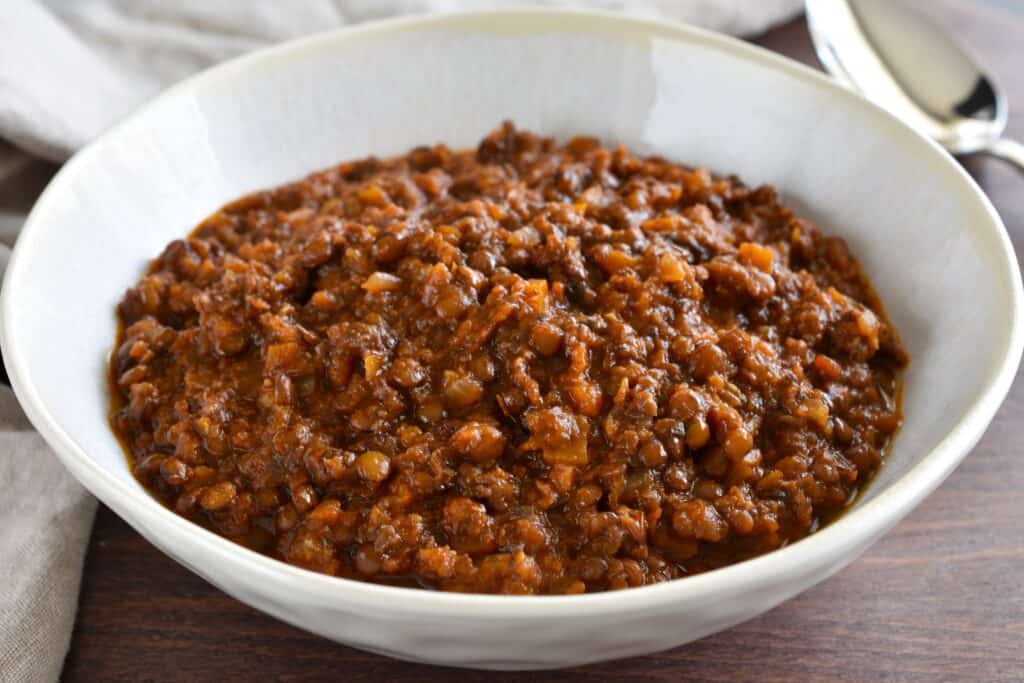
About this recipe
Having explained all that, no doubt you’ll agree that vegan ragu is a more suitable name for this dish. It sort of means I can make substitutions without feeling guilty about calling a recipe something it is not. After all, the Italians themselves have invented ragù di pesce (fish), ragù di verdure (vegetables) and ragù di funghi (mushrooms).
Soffritto is the foundation for any bolognese or ragu worth its salt. It’s also the base for numerous other Italian sauces and stews. Soffritto is a combination of finely diced onion, carrot and celery, which is gently sautéed until soft and translucent. Slow cooking is the art of making the best Italian sauces.
In this recipe, I’ve substituted meat with the earthy, meaty flavour and texture of Italian lentils and finely chopped brown cremini mushrooms. As far as the other ingredients are concerned, I’ve pretty much stuck to the original recipe. Any minor deviations are mentioned in the ingredient list below. The result is a sauce which is every bit as delicious as real meat ragu, and the great thing is that no animals have been harmed, so you can indulge with a clear conscience!
Note that there is no garlic in Italian bolognese or ragu, so you won’t find it in this recipe either. The same applies to rosemary. There are no herbs of any kind in authentic ragu or bolognese.
This vegan lentil ragu is perfect with pasta – especially tagliatelle, pappardelle, rigatoni, paccheri, spaghetti, penne, and fettuccine, – with lasagna or with homemade gnocchi. Remember that some brands of flat pasta like lasagne, tagliatelle etc, contain eggs!
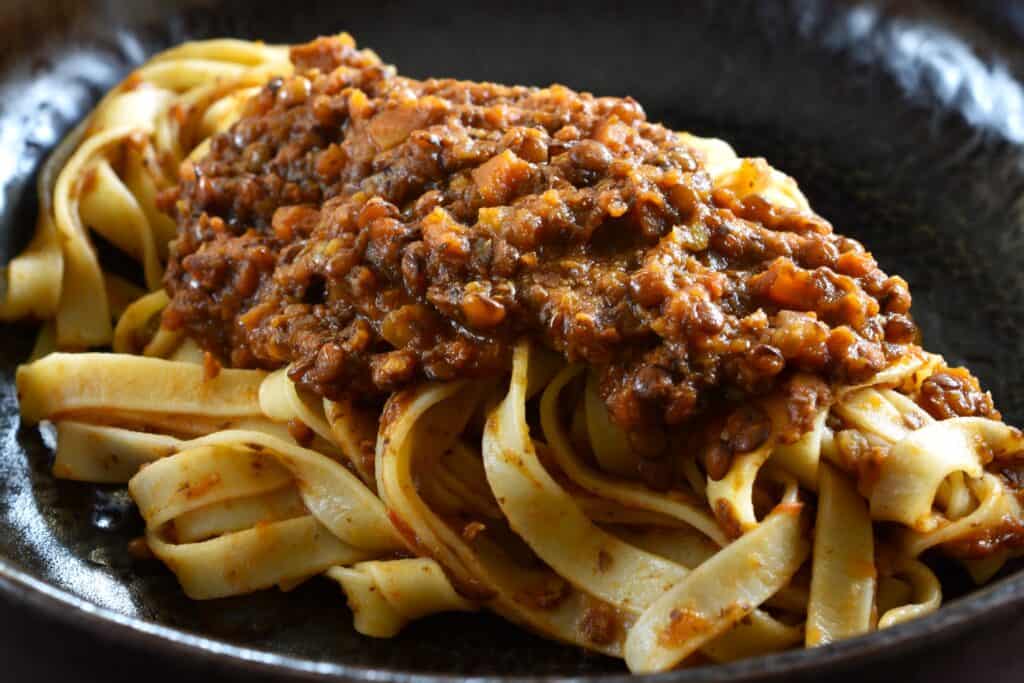
How to make vegan lentil ragu
Ingredients
extra virgin olive oil
Extra virgin olive oil is best for this recipe. It’s the most widely used oil in Italy. It’s a superior quality oil that handles heat well.
lentils
I recommend using dried lentils for this recipe because the lentils will absorb the flavours of the soffritto and seasoning while they are cooking. In the recipe card below, you will find indications on how to substitute dried lentils with tinned lentils if you want to. I recommend you read the footnotes very carefully because you’ll need to make some adaptions if using tinned lentils
I used small Italian lentils for this recipe, which is the most obvious choice. Either brown or green are fine. Red split lentils are not suitable, and neither are Indian dahl lentils. Lentils enrich this vegan ragu with minerals, iron, and plant protein.
onion, carrot and celery
Yellow onion is the most commonly used for ragu. Carrots and celery should be firm and fresh. This trio forms your soffritto.
mushrooms
Use brown cremini mushrooms if you can get hold of them. White ones are also fine, as are portobello. Mushrooms add umami flavour and a meaty texture. They also make the sauce richer and darker, like meat ragu. Some people hate mushrooms. You won’t be able to taste them in this recipe, but you can omit them if you prefer.
red wine
I use red wine, although you can use white instead if you want.
tomato sauce
Most recipes use Italian passata, the smooth tomato sauce in a glass bottle. I use Mutti tomato pulp because I love the flavour and consistency, which is similar to fresh tomatoes. If you use passata, Mutti is a good brand. You’ll only need half the amount stated in this recipe because it’s more concentrated. Dilute the passata with the same amount of water.
tomato paste (double or triple concentrate)
Tomato paste makes the sauce darker and richer.
vegetable broth
Have a pan of hot vegetable broth on hand for whenever you need to add some. Homemade vegetable broth is quick and easy to make. Just put an onion, a carrot, a stick of celery and a little leek in a litre of water and simmer them while you make the dumplings. By the time you’ve done, the broth will be ready. Add a little unrefined sea salt, and you’ve got a healthy homemade vegetable broth! Or go one step further and make your own vegetable broth from carrot peelings, the outer layers of onion, celery and leek trimmings – a zero-waste idea to use up kitchen scraps and make great homemade vegetable broth. If that all sounds too complicated, just use store-bought vegetable stock cubes or powder.
salt and pepper
Salt and pepper are the only seasonings in ragu or bolognese. Unrefined sea salt is the best option, preferably unrefined Atlantic sea salt. I use freshly ground black pepper. White pepper is too strong.
How to make vegan ragu with lentils – Instructions
A few tips before you start
- This lentil ragu recipe can be made in any thick-bottomed saucepan.
- Consider making a large batch – it’ll save you so much time another day. Lentil ragu keeps and freezes really well. Keeping it in the fridge for a couple of days allows the flavours to really meld and improve over time.
- This makes it a great dish to prepare ahead for a special meal.
- Take your time with the soffritto. Chefs recommend chopping the onion, carrot and celery by hand with a sharp knife. It takes a little longer, but it’s worth the extra effort. If you’re in a hurry, you can chop them up in a food processor. Sauté your soffritto gently, on a low heat. Your aim is to soften it, not brown it.
- Your vegan ragu will take about an hour to cook. You’ll only need to stir it every 10 – 15 minutes just to make sure it doesn’t stick to the bottom of the pan.
How to make soffritto
- Finely chop the onion, carrot, and celery, preferably by hand. Otherwise, use a food processor; roughly chop the vegetables beforehand so that the processor can chop them more evenly.
How to make the vegan ragu sauce
- Put the finely chopped onion, carrots and celery into a pan with the oil. Turn the heat on low and saute gently until soft and translucent. This will take approximately 10 minutes.
- Cut the mushrooms into quarters and put them in a food processor or blender. Pulse until very finely chopped. Turn up the heat to medium and add the mushrooms to the pan. Sauté for 2 – 3 minutes until the pan is dry.
- Put the lentils in a sieve and rinse them under running water. Add them to the pan.
- Turn the heat up to high and add the wine, stirring constantly. When the wine has evaporated, add the tomato pulp (or passata) and the tomato paste.
- Add half of the vegetable broth and season with salt and pepper. When the ragu comes to the boil, turn the heat down and put a lid on the pan.
- Simmer on low heat until the lentils are cooked, adding more stock as necessary. The lentils should be soft but still hold their shape. The sauce should have the same consistency as traditional ragu or bolognese. However, feel free to cook them according to your own personal liking. Taste and correct the seasoning if necessary.
- I recommend partly blending some of the sauce with an immersion blender to make the ragu more similar in texture to the original recipe. By this, I mean pulse for a split second here and there – just enough to break up some of the lentils, not reduce them to purée.
Your vegan ragu is now ready to be used for all your delicious culinary creations!
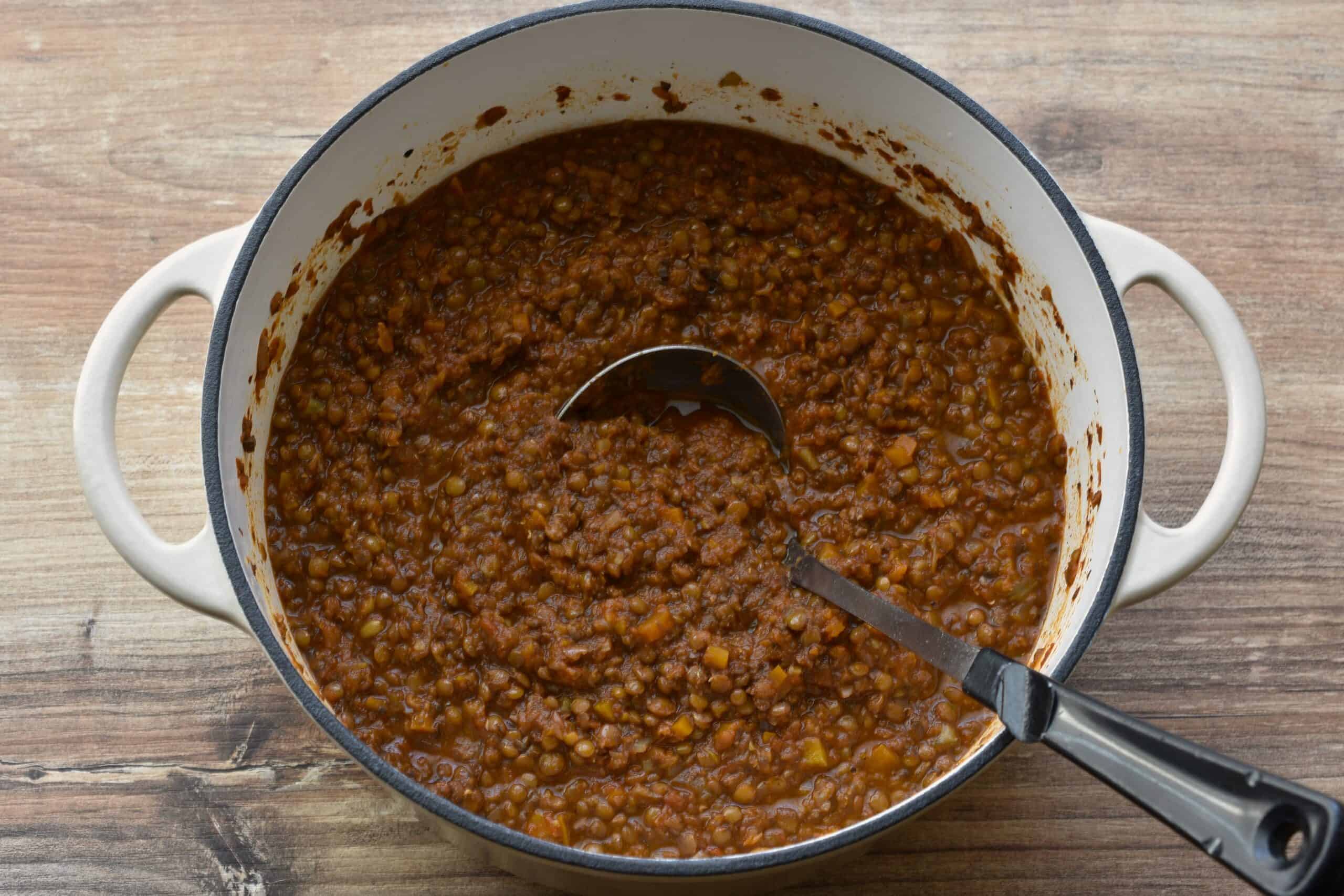
What is the traditional way to serve ragu in Italy?
In Italy, ragu is traditionally served as a sauce for pasta. One of the most iconic pairings is tagliatelle, which complements the rich and hearty texture of the ragu. Tagliatelle al ragù is particularly associated with the Emilia-Romagna region. Ragù alla bolognese is always paired with tagliatelle in Bologna. Other pasta strips like pappardelle or fettuccine also work well. The pasta should have a good surface area for the sauce to adhere to.
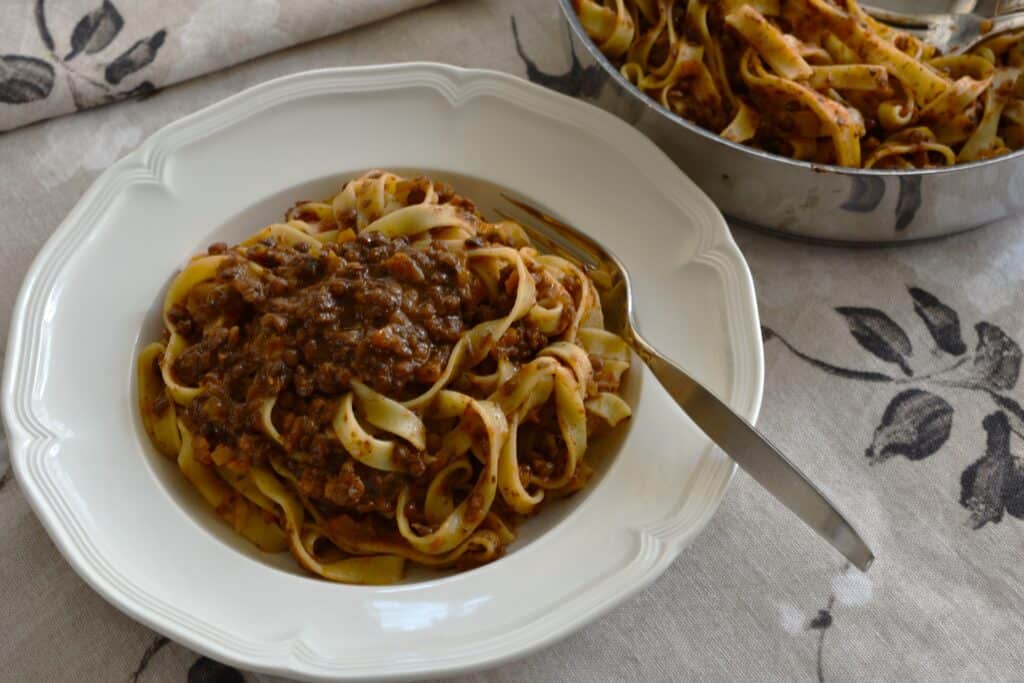
While tagliatelle al ragù is a classic, Italians also use ragu in other dishes, such as layered in lasagne or as a filling for cannelloni, etc.
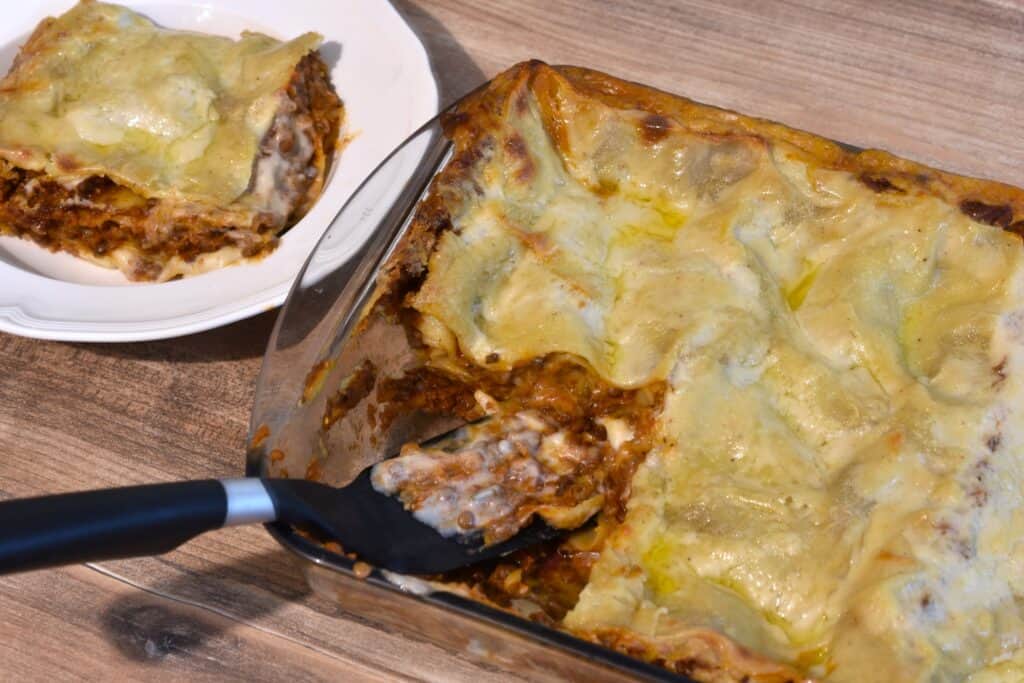
Italians add the pasta to the sauce, and not vice versa. The pasta is often slightly undercooked when it’s added to the pan with the hot sauce. The pasta finishes cooking in the sauce and is strictly al dente. Another popular trick is to add a tablespoon or two of the cooking water while the pasta finishes cooking in the sauce. The starchy cooking water becomes a natural thickener and emulsifier, helping the sauce adhere better to the pasta and creating a creamy and velvety consistency. Adding a generous spoonful of ragu over the plated pasta adds to the appearance of the dish as well as making it even more succulent!
In Italy, people don’t normally garnish pasta and ragu with anything – no basil, no rosemary, and definitely not parsley.
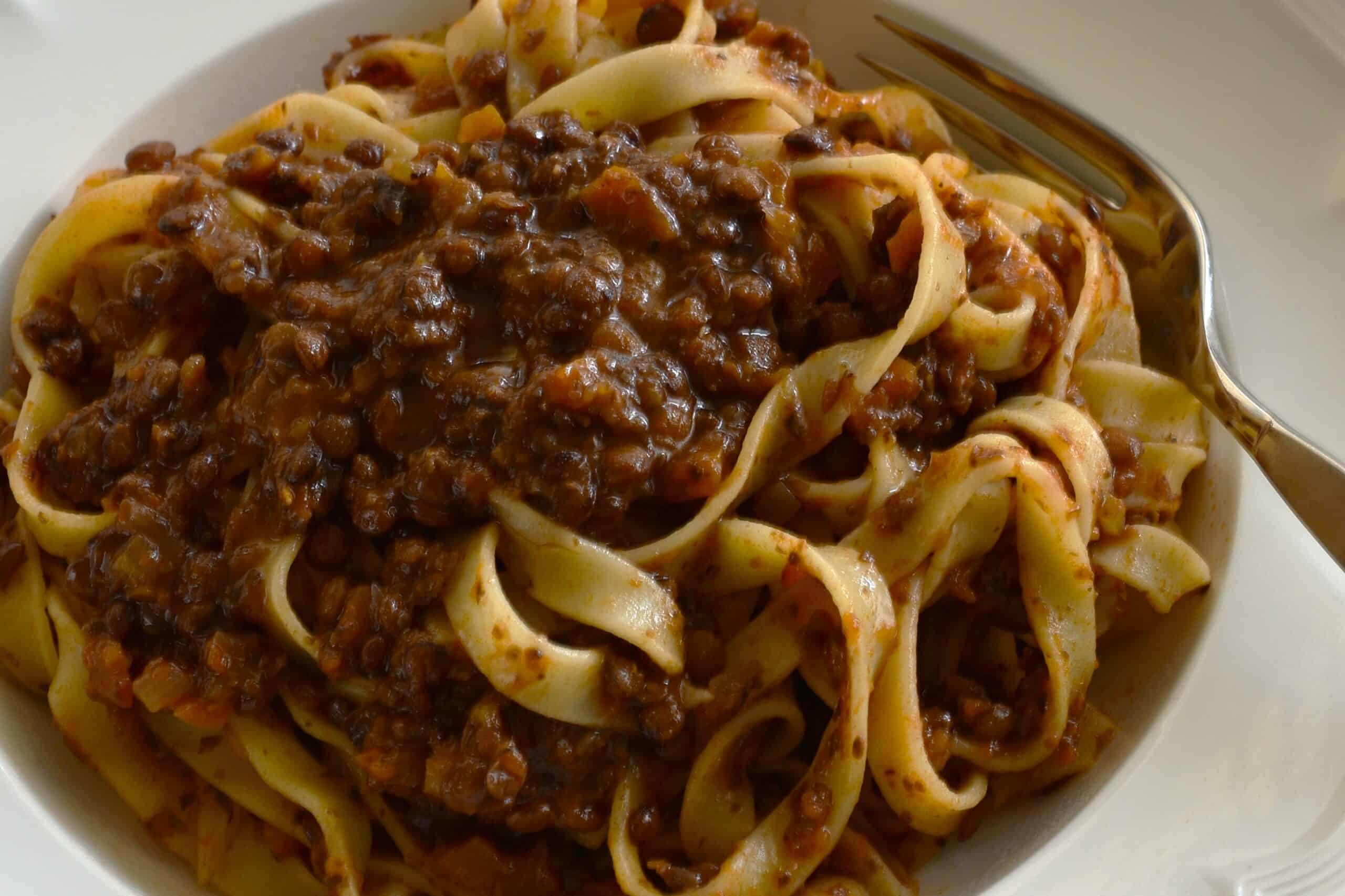
How to store leftover vegan ragu
You can store leftover lentil ragu in an airtight container in the fridge, where it will keep for 4 – 5 days.
How to reheat it
Reheat your lentil ragu very slowly in a pan with a lid until it is hot again. Add a little water or vegetable broth if the ragu seems too dry.
Can you freeze vegan lentil ragu?
Yes, you can! This lentil ragu freezes very well. Allow it to cool down completely. Then, put it in an airtight container in the freezer, where it will keep for up to 3 months. To reheat from frozen, first allow the ragu to defrost completely, and then proceed as above.
Before you go…
I put a lot of effort into this recipe and tested it multiple times before posting. I also ate tons of it for days while testing and taking photos, and never got sick of it! If you make it according to the recipe, I’m sure you’ll love this vegan ragu! If you do, please leave a 5-star review and a comment below – your positive reviews always makes my day!
While you’re here on Vegan Hot Stuff, maybe you’d like to take a look at some other popular recipes…
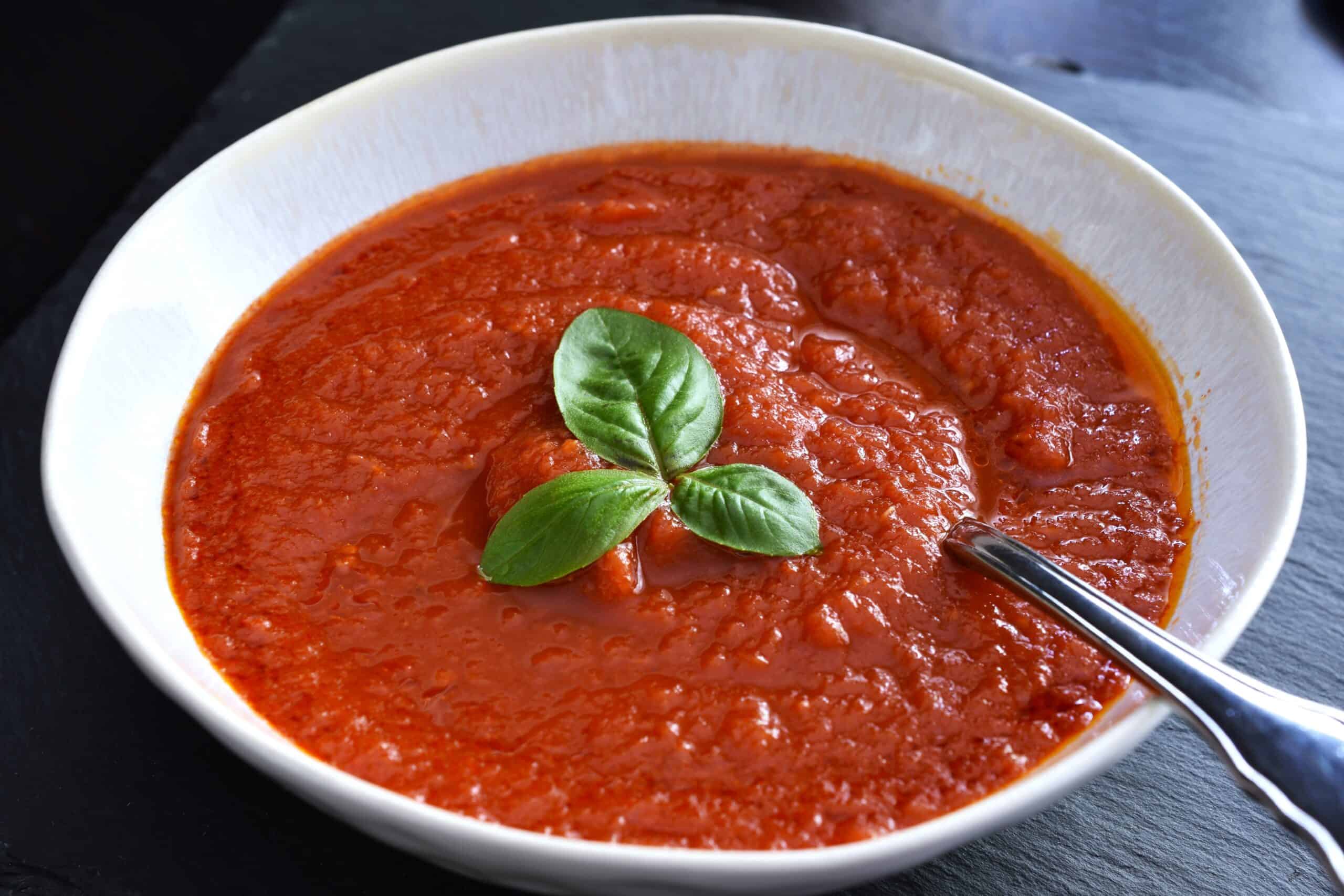
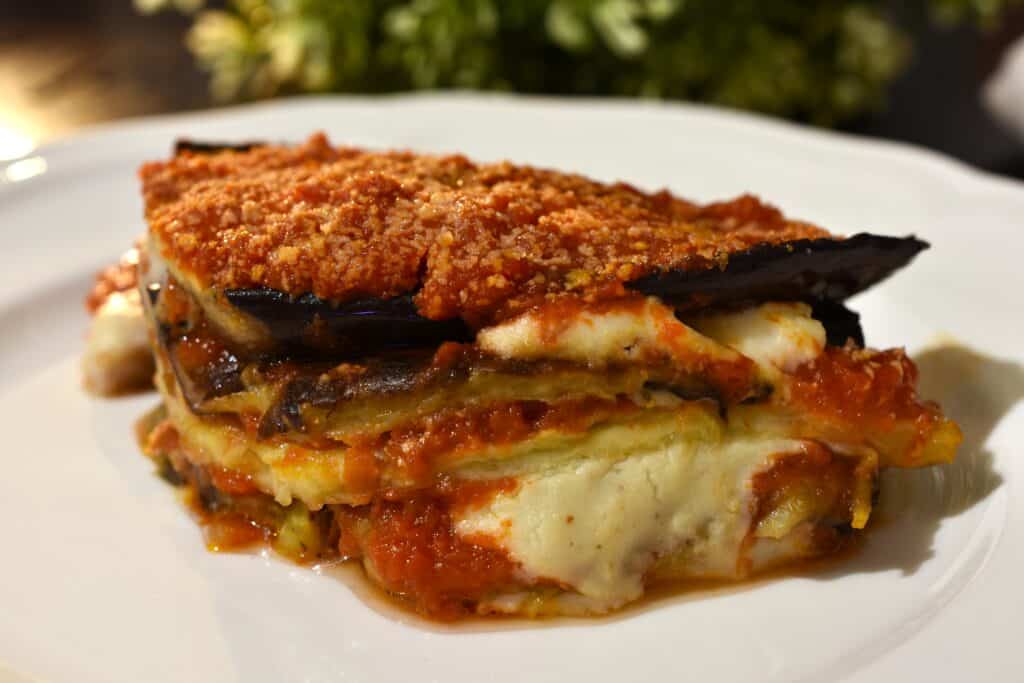
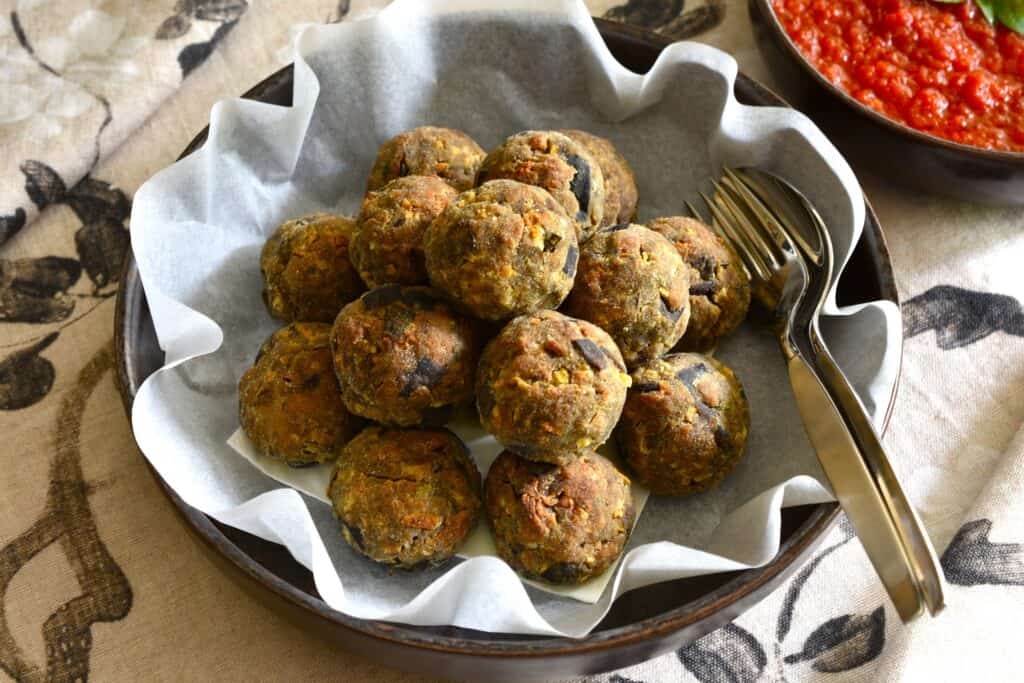
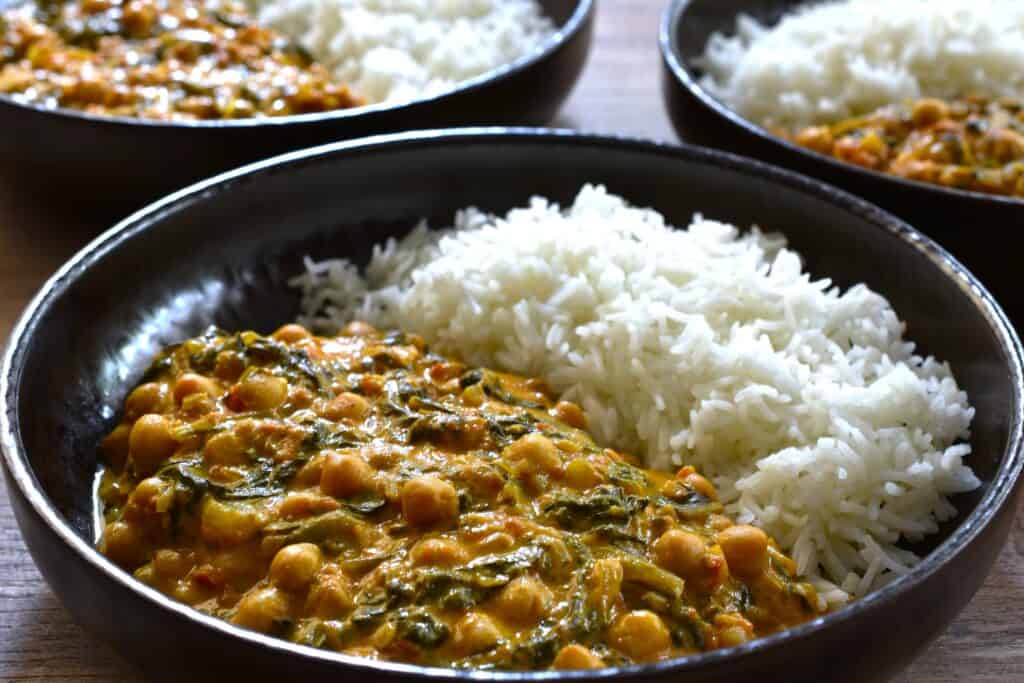
If you liked my recipe for vegan lentil ragu, it would be great if you could rate it and leave a comment below! It helps me immensely, and it also helps others discover my blog and recipes. Thank you for supporting Vegan Hot Stuff! Deborah xxx
Subscribe below to receive more vegan recipes as soon as I publish them!


